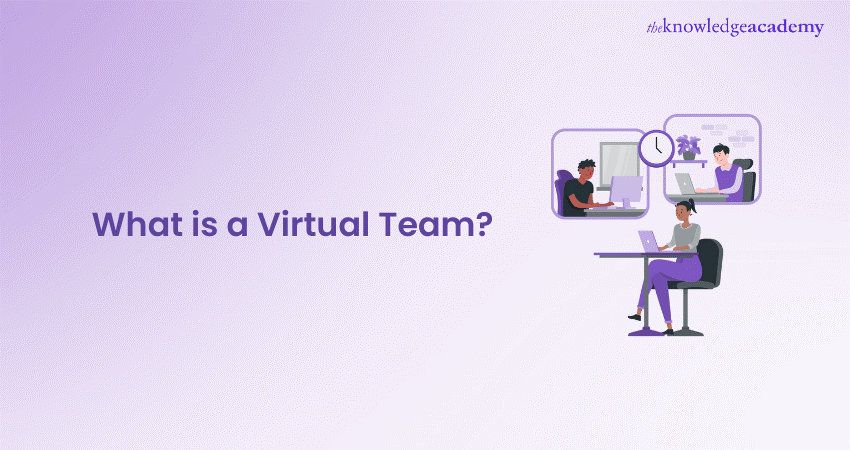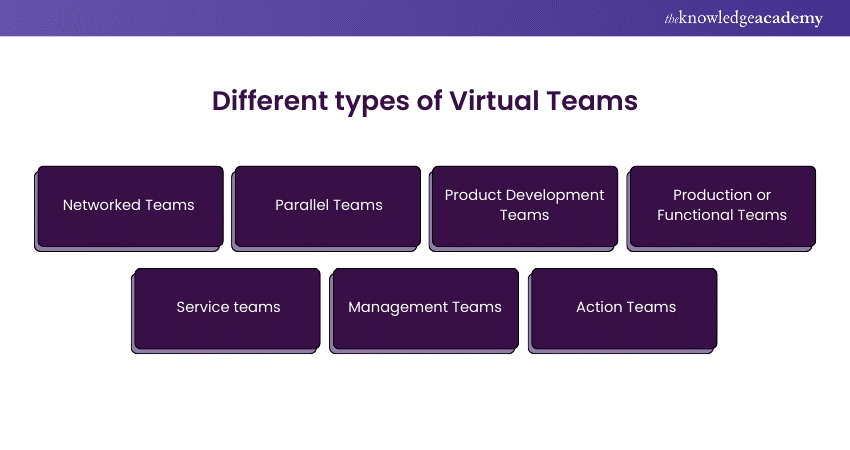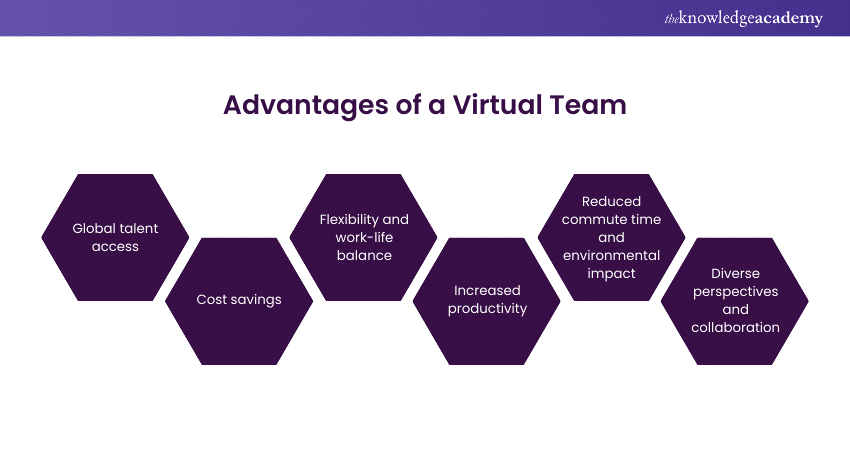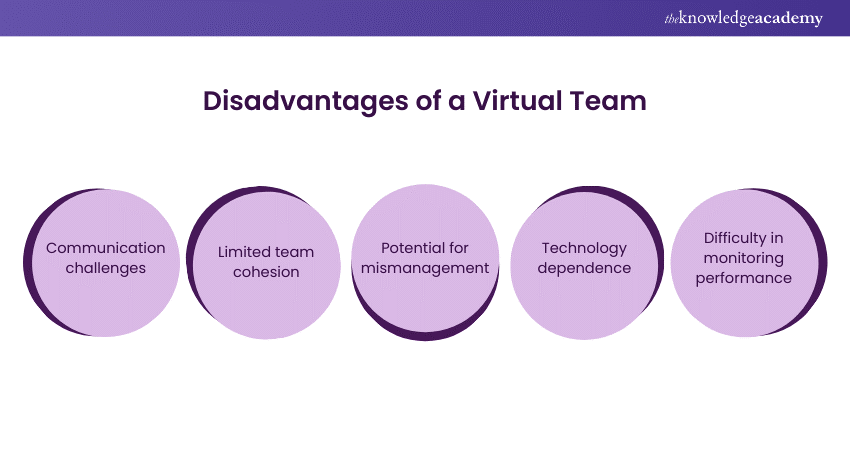We may not have the course you’re looking for. If you enquire or give us a call on 01344203999 and speak to our training experts, we may still be able to help with your training requirements.
Training Outcomes Within Your Budget!
We ensure quality, budget-alignment, and timely delivery by our expert instructors.

Are you curious about modern workplace dynamics? Wondering how teams collaborate effectively in today's digital age? If so, you might be interested in learning about Virtual Teams. So, "What is a Virtual Team?” you may ask. In this comprehensive blog, we'll explore the concept of Virtual Teams, their benefits, challenges, and best practices.
Whether you're a manager seeking to optimise remote work strategies or a team member navigating virtual collaboration tools, understanding "What is a Virtual Team?" is essential in today's globalised and remote-friendly work environment.
Table of Contents
1) What is a Virtual Team?
2) How do Virtual Teams collaborate?
3) Different types of Virtual Teams
4) Advantages of a Virtual Team
5) Disadvantages of a Virtual Team
6) Examples of Virtual Teams
7) Conclusion
What is a Virtual Team?
A Virtual Team is a group of individuals from different locations who collaborate and work together on projects or tasks, often using communication technologies such as email, video conferencing, and collaboration platforms. Unlike traditional teams in the same physical location, Virtual Teams operate remotely, allowing members to work from home, satellite offices, or even in different countries.
Virtual Teams enable organisations to leverage diverse talent pools, reduce overhead costs associated with office space, and accommodate flexible work arrangements. However, they also present unique challenges, such as communication barriers, time zone differences, and the need for effective team management strategies to ensure productivity and cohesion.
Successful Virtual Teams prioritise clear communication, establish trust among team members, and utilise technology effectively to overcome geographical barriers and achieve shared goals
How do Virtual Teams collaborate?
Virtual Teams collaborate using various communication tools and technologies to overcome geographical barriers and work together effectively. These include:
a) Communication platforms: Virtual Teams rely on email, instant messaging, and video conferencing platforms to facilitate real-time communication and discussions.
b) Collaboration software: Tools like shared document repositories, project management platforms, and virtual whiteboards enable team members to collaborate on documents, track progress, and assign tasks.
c) Virtual meetings: Regular video conferences and virtual meetings allow team members to discuss projects, brainstorm ideas, and make real-time decisions, fostering collaboration and teamwork.
d) File sharing: Cloud storage services and file-sharing platforms enable team members to share documents, presentations, and other files securely, ensuring everyone can access the necessary resources.
e) Task management: Task management tools help Virtual Teams organise and prioritise tasks, assign responsibilities, and track progress to ensure projects stay on schedule.
Unlock the secrets to mastering virtual consulting and elevate your expertise with our Virtual Consultant Masterclass today!
Different types of Virtual Teams

Virtual Teams have become increasingly prevalent in today's globalised and digitally connected workplace. These teams, comprising members dispersed across various geographical locations, collaborate virtually to achieve common goals. Let's delve into the different types of Virtual Teams and explore their unique characteristics:
1) Networked Teams
Networked teams are decentralised groups of individuals with diverse expertise and skill sets who collaborate across different departments or geographical locations. Here are five key features of networked teams:
a) Decentralised structure: Networked teams are dispersed across different departments or geographical locations, allowing organisations to tap into diverse expertise and resources.
b) Flexibility and adaptability: These teams are highly flexible and adaptable, making it easier to scale operations and collaborate across organisational boundaries.
c) Information sharing: Networked teams rely on digital communication tools and platforms to share information, exchange ideas, and coordinate real-time activities.
d) Cross-functional collaboration: Members of networked teams come from diverse backgrounds and disciplines, enabling multidisciplinary collaboration and innovation.
e) Resource optimisation: Networked teams can optimise resource allocation and achieve better results by leveraging the expertise and resources of different departments or locations.
2) Parallel Teams
Parallel teams operate simultaneously alongside existing functional teams within an organisation. Here are their key features:
a) Parallel structure: Parallel teams operate alongside existing functional teams, addressing specific projects or initiatives without disrupting ongoing operations.
b) Dedicated focus: These teams are formed to tackle specific projects or initiatives, ensuring focused efforts and accelerated timelines.
c) Cross-functional expertise: Parallel teams often include members from different departments, bringing diverse perspectives and skill sets.
d) Project-based collaboration: Members collaborate on project-based tasks and deliverables, working towards a common goal within a defined timeframe.
e) Rapid decision-making: Parallel teams prioritise rapid decision-making and agile project management practices to drive progress efficiently.
3) Product Development Teams
Product development teams design, develop, and launch new products or services. Here are their key features:
a) Cross-departmental collaboration: Members from various departments collaborate closely to bring innovative ideas to fruition.
b) Innovation and creativity: These teams foster a culture of innovation and creativity to develop groundbreaking products.
c) Iterative development process: Product development teams follow an iterative process, allowing continuous feedback and improvement.
d) Market research and analysis: Members conduct market research to identify customer needs and inform product development decisions.
e) Timely delivery: These teams prioritise timely delivery, leveraging project management methodologies to streamline development.
Master remote work skills with our Virtual Online Job Roles Training and excel in the digital workspace!
4) Production or Functional Teams
Production or functional teams focus on executing day-to-day operations within an organisation. Here are their key features:
a) Operational efficiency: These teams ensure operational efficiency and effectiveness in executing daily tasks.
b) Role-based responsibilities: Members have specific roles and responsibilities, contributing to the smooth functioning of operations.
c) Standardised processes: They rely on standardised processes and workflows to ensure consistency and quality.
d) Task automation: Automation tools streamline repetitive tasks, optimising workflows for efficiency.
e) Continuous improvement: These teams prioritise continuous improvement, driving enhancements in processes and performance.
5) Service teams
Service teams provide specialised services or support to internal or external stakeholders. Here are their key features:
a) Customer focus: Service teams prioritise customer satisfaction and responsiveness in delivering services.
b) Expertise and knowledge: Members possess expertise in their respective domains, providing valuable support and solutions.
c) Collaborative problem-solving: They collaborate to address complex issues and challenges, leveraging collective expertise.
d) Service excellence: These teams aim for excellence in service delivery, exceeding customer expectations.
e) Effective communication: Clear communication ensures seamless coordination and delivery of services.
6) Management Teams
Management teams consist of senior leaders and executives responsible for strategic planning and decision-making. Here are their key features:
a) Strategic vision: Management teams set the direction and vision for the organisation, aligning resources to achieve strategic objectives.
b) Decision-making authority: They have the authority to make key decisions impacting the organisation's direction and performance.
c) Leadership and guidance: Senior leaders provide guidance and leadership to drive organisational success.
d) Performance management: Management teams review performance metrics and make data-driven decisions to improve performance.
e) Effective communication: Clear communication ensures alignment with organisational goals and objectives.
7) Action Teams:
Action teams are formed to address specific challenges or opportunities within an organisation. Here are their key features:
a) Task orientation: These teams focus on achieving specific objectives or outcomes within a defined timeframe.
b) Problem-solving: Members collaborate to identify solutions and implement actions to address challenges or opportunities.
c) Agile approach: Action teams adopt an agile approach to adapt quickly to changing circumstances and requirements.
d) Resource allocation: They allocate resources efficiently to execute actions and achieve desired outcomes.
e) Results orientation: Action teams are results-driven, prioritising actions contributing to organisational goals and objectives.
Enhance your leadership skills and optimise team performance with our Managing Virtual Teams Course.
Advantages of a Virtual Team

Here are six advantages of Virtual Teams:
a) Global talent access: Virtual Teams allow organisations to access a diverse pool of talent worldwide, enabling them to recruit the best individuals for specific roles regardless of geographical location.
b) Cost savings: Operating Virtual Teams can significantly reduce overhead costs associated with maintaining physical office spaces, such as rent, utilities, and office supplies, leading to substantial cost savings for organisations.
c) Flexibility and work-life balance: Virtual Teams offer flexibility in work hours and locations, allowing team members to balance their professional and personal lives better. This flexibility can lead to increased job satisfaction and employee retention.
d) Increased productivity: With Virtual Teams, team members can work from environments where they feel most comfortable and productive. Additionally, virtual collaboration tools streamline communication and project management, improving productivity and efficiency.
e) Reduced commute time and environmental impact: Virtual Teams eliminate the need for daily commutes to a central office, saving team members time and reducing their carbon footprint. This reduction in travel also contributes to improved air quality and reduced traffic congestion.
f) Diverse perspectives and collaboration: Virtual Teams bring together individuals from different cultural backgrounds, experiences, and perspectives. This diversity fosters creativity, innovation, and collaboration, leading to better problem-solving and decision-making within the team.
Disadvantages of a Virtual Team

Here are five disadvantages of Virtual Teams:
a) Communication challenges: Virtual Teams may experience communication barriers due to reliance on digital communication tools. Misunderstandings, lack of non-verbal cues, and time zone differences can hinder effective communication and collaboration.
b) Limited team cohesion: Physical distance and lack of face-to-face interaction can impede the development of strong team cohesion and trust. Team members may feel isolated or disconnected from their colleagues, decreasing morale and motivation.
c) Potential for mismanagement: Virtual Teams may struggle to align with organisational goals and deadlines without proper oversight and management. Poorly managed Virtual Teams may experience issues with accountability, task prioritisation, and project coordination.
d) Technology dependence: Virtual Teams rely heavily on technology for communication and collaboration. Technical glitches, software compatibility issues, and connectivity problems can disrupt workflow and productivity, causing delays and frustration among team members.
e) Difficulty in monitoring performance: Supervising and evaluating the performance of Virtual Team members can be challenging. Without direct supervision, managers may struggle to assess individual contributions, address performance issues, and provide timely feedback.
Unlock the secrets of effective virtual recruitment with our Online Virtual Recruiter Masterclass and take your hiring process to the next level!
Examples of Virtual Teams
Here are some real-world examples of remote workplaces:
1) Twitter
Twitter, the social media platform, operates with Virtual Teams dispersed across different locations worldwide. From Software Engineers to Product Managers, marketing specialists, and customer support representatives, Twitter's Virtual Teams collaborate remotely to develop and maintain the platform, manage user engagement, and support advertising campaigns. They utilise virtual collaboration tools like Slack and Zoom to coordinate their efforts and ensure seamless communication despite geographical distances.
2) IBM
IBM, a multinational technology company, employs Virtual Teams across various departments and business units to drive innovation, develop new technologies, and deliver consulting services to clients globally. From research scientists, software developers, sales professionals, and project managers, IBM's Virtual Teams work remotely to design and implement solutions for client's business challenges. They leverage IBM's suite of collaboration tools, including IBM Connections and IBM Watson Workspace, to collaborate effectively and deliver value to clients irrespective of physical location.
3) Buffer
Buffer, a social media management platform, operates as a fully remote company with Virtual Teams distributed worldwide. From product development and marketing to customer success and operations, Buffer's Virtual Teams collaborate remotely to build and improve the platform, attract and retain customers, and provide exceptional user support. They rely on virtual collaboration tools like Trello, Slack, and Zoom to facilitate communication, project management, and team collaboration, ensuring alignment and productivity despite being geographically dispersed.
4) GitHub
GitHub, a web-based platform for Software Developers to collaborate on code projects, operates with Virtual Teams distributed across different regions. From Software Engineers and Product Managers to Technical Support Specialists and Community Managers, GitHub's Virtual Teams work remotely to develop and maintain the platform, support users, and foster collaboration among developers worldwide. They use GitHub's collaboration tools, such as GitHub Issues and GitHub Projects, along with communication platforms like Slack and Zoom, to coordinate their efforts and enhance the developer experience.
5) Zapier
Zapier, a web automation tool that connects different apps and services, operates as a fully remote company with Virtual Teams spread across various functions and locations. From Software Developers and customer support representatives to marketing professionals and operations specialists, Zapier's Virtual Teams collaborate remotely to improve the platform, assist users, and grow the business. They rely on virtual collaboration tools like Asana, Slack, and Zoom to streamline workflows, communicate effectively, and achieve their goals despite being geographically dispersed.
Conclusion
In conclusion, understanding “What is a Virtual Team?” is essential for navigating today's dynamic workspaces. By embracing the insights shared in this comprehensive guide, leaders can harness the full potential of Virtual Teams, fostering collaboration, driving productivity, and achieving success in an increasingly digital world.
Elevate your virtual event planning skills with our Virtual Event Planner Masterclass and create unforgettable online experiences.
Frequently Asked Questions

Effective communication with Virtual Team members involves using various communication tools like video conferencing, chat platforms, and emails. Establishing clear communication channels, setting expectations, and encouraging open dialogue are crucial to ensure everyone stays informed and engaged despite geographical barriers.

When leading Virtual Teams, common challenges include communication barriers, lack of team cohesion, and time zone differences. These can be addressed by using collaboration tools, scheduling regular check-ins, fostering team bonding activities, and establishing clear expectations and goals for each team member.

The Knowledge Academy takes global learning to new heights, offering over 30,000 online courses across 490+ locations in 220 countries. This expansive reach ensures accessibility and convenience for learners worldwide.
Alongside our diverse Online Course Catalogue, encompassing 17 major categories, we go the extra mile by providing a plethora of free educational Online Resources like News updates, Blogs, videos, webinars, and interview questions. Tailoring learning experiences further, professionals can maximise value with customisable Course Bundles of TKA.

The Knowledge Academy’s Knowledge Pass, a prepaid voucher, adds another layer of flexibility, allowing course bookings over a 12-month period. Join us on a journey where education knows no bounds.

The Knowledge Academy offers various Virtual Online Job Roles Trainings, including Virtual Assistant (VA) Masterclass, Managing Virtual Teams Course and Virtual Consultant Masterclass. These courses cater to different skill levels, providing comprehensive insights into How to Become an Event Manager.
Our Business Skills blogs cover a range of topics related to Virtual Online Job Roles, offering valuable resources, best practices, and industry insights. Whether you are a beginner or looking to advance your Virtual Team Management skills, The Knowledge Academy's diverse courses and informative blogs have you covered.
Upcoming Business Skills Resources Batches & Dates
Date
 Virtual Assistant Course
Virtual Assistant Course
Fri 14th Jun 2024
Fri 11th Oct 2024
Fri 20th Dec 2024







 Top Rated Course
Top Rated Course



 If you wish to make any changes to your course, please
If you wish to make any changes to your course, please


